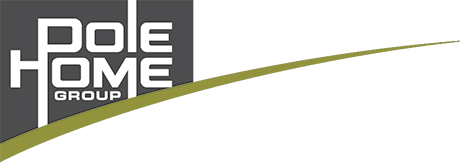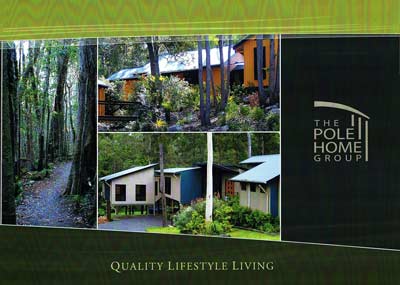How Much Does it Cost to Build a Pole Home?
Almost every conversation with my clients about building on a sloping block starts with the question about the cost. And it’s an important question, right?
The best answer I can give you is this…
There are a number of variables that make up the cost to build a pole home. It certainly does cost more to build a pole home than a comparable size standard concrete ‘slab on ground’ home.
Why the Higher Cost for a Pole Home?
The increased price to build a pole home compared to a similar size concrete floor/slab on ground home is of course due the slope of the block. There are several reasons that increase the cost to build. Here are the main ones:
Site Classification
All residential building sites have a classification (see Table 1 below). Most sloping sites classification require special engineering design to determine the subfloor structure, including bracing, piers and bearers. Both the extra engineering design and increased structural components add more cost.
Our inclusions allow for a build on an a standard ‘M’ class site with and N3 wind rating.
Piers and Poles
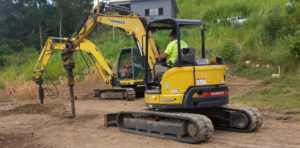 We need to bore deep piers into the ground that we fill with concrete to hold the poles. A Geotech Report may also highlight the need for more or increased depth of piers and poles to secure your home on the slope. The poles also require bracing so your home doesn’t move. Depending on the sites classification and wind rating, more bracing may also be required as mentioned above.
We need to bore deep piers into the ground that we fill with concrete to hold the poles. A Geotech Report may also highlight the need for more or increased depth of piers and poles to secure your home on the slope. The poles also require bracing so your home doesn’t move. Depending on the sites classification and wind rating, more bracing may also be required as mentioned above.
Floor System
 Once the poles are in the ground we can then proceed to install the floor system. This is pretty standard on all pole homes, requiring bearers, ‘I’ beam joists and a particle board floor that we glue and screw to the joists. This can take up 3 weeks to get to the same stage that a slab on ground takes 3 – 4 days. So there is also an increased labour component in the subfloor as well as materials.
Once the poles are in the ground we can then proceed to install the floor system. This is pretty standard on all pole homes, requiring bearers, ‘I’ beam joists and a particle board floor that we glue and screw to the joists. This can take up 3 weeks to get to the same stage that a slab on ground takes 3 – 4 days. So there is also an increased labour component in the subfloor as well as materials.
Decks
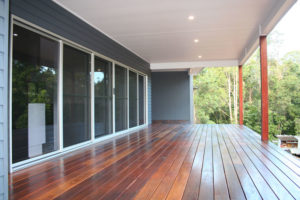 A pole home has to have a deck. Because the home is well above the natural ground level, there needs to be an easily accessible outdoor living area. In our standard Pole Home designs the decks are a generous size and they’re built with the house roof over them. This means the roof area is a bigger than the actual livable house area – this distorts the square meter build cost and of course increases the cost of the build.
A pole home has to have a deck. Because the home is well above the natural ground level, there needs to be an easily accessible outdoor living area. In our standard Pole Home designs the decks are a generous size and they’re built with the house roof over them. This means the roof area is a bigger than the actual livable house area – this distorts the square meter build cost and of course increases the cost of the build.
Scaffolding
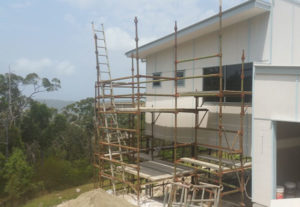 During the construction process we use scaffolding to access the home as we build it so we can add the roof, cladding and paint it. Slab on ground homes do not require scaffolding.
During the construction process we use scaffolding to access the home as we build it so we can add the roof, cladding and paint it. Slab on ground homes do not require scaffolding.
Crane
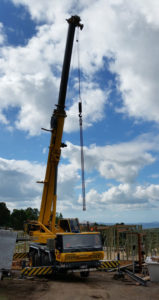 During the build we may use cranes to lift construction materials onto the house. Depending on the lift distance this can be a significant added cost, especially if we need to stop traffic.
During the build we may use cranes to lift construction materials onto the house. Depending on the lift distance this can be a significant added cost, especially if we need to stop traffic.
Pole Home Build Price vs Block Purchase Price
One of the most frequent inquiries I get is from people who are looking at, or have brought a cheaper block of sloping land thinking they’ll be able to build a house on this for the cost of a slab on ground build. Unfortunately that is not generally the case.
Often when you buy a sloping block that requires a pole home, the cost of the sloped property can be much less than an equivalent flat, or near flat site that could have a ‘slab on ground’ build. So the overall combined cost (lower land cost and increased build cost) of your beautiful new home and land, may not be too much more than a flat site build.
In some cases a slab on ground could be built on a sloping site but this would require special engineering design, major earthworks and retaining wall construction not to mention how ugly all that would look. This would all incur extra costs that work out to a similar cost as a pole home build anyway, and of course you don’t get the same view or character.
Superior Standard Inclusions
Our standard inclusions are more than what you’ll find on many home building packages. For instance I include real T&G hardwood flooring to the living area. To me it just makes sense to include better quality inclusions so that the contract build price will build you a beautiful home without the added costs.
Building with the Pole Home Group
The major benefit to you building with the Pole Home Group is simple. I will design your home to meet both your needs and lifestyle in a home. You get a beautiful new home that fits onto your site, makes the most of the site by retaining its natural beauty and features and most of all – you get an outlook!
My standard design pole homes start in the low $300,000’s to build (see Standard Design Portfolio). Now you may get a builder that says they can do it cheaper, but the price I give you is the all inclusive finished build price. There are no nasty surprises or vague promises about what is and isn’t included. I’ve set my standard inclusions so you can relax knowing we take care of everything. Also, I will not compromise the quality or integrity of the home we build for you – we don’t take shortcuts.
And remember my standard inclusions mean there are no extra costs on your new pole home. When we finish your home I get cleaners in to give it a thorough clean so you can just back the truck up, move in and start living! Easy!
To discuss this or anything else I can help you with, please don’t hesitate to contact me.
Look forward to talking soon.
Craig Neilson
Ph: 0408 727 755
Table 1: Site classifications and movement based on soil reactivity
Class A (0-10mm) | Stable, non-reactive. Most sand and rock sites. Little or no ground movement likely as a result of moisture changes. |
Class S (10-20mm) | Slightly reactive clay sites. May experience slight ground movement as a result of moisture changes. |
Class M / M-D | Moderately reactive clay or silt sites. May experience moderate ground movement as a result of soil conditions and moisture changes. |
Class H1 / H1-D (40-60mm) | Highly reactive clay sites. May experience a high amount of ground movement as a result of soil conditions and moisture changes. |
Class H2 / H2-D (60-75mm) | Highly reactive clay sites. May experience very high ground movement as a result of soil conditions and moisture changes. |
Class E / E-D (75mm+) | Extremely reactive sites. May experience extreme amounts of ground movement as a result of soil conditions and moisture changes. |
Class P (this is approximately 70% of building sites in Australia) | Problem sites. The ability of the soil to evenly bear a load is very poor. Sites may be classified as ‘Class P’ as a result of mine subsidence, landslip, collapse activity or coastal erosion (e.g. dunes), soft soils with a lack of suitable bearing, cut and/or filled sites, or creep areas. |
The ‘D’ inclusion (i.e M-D, H1-D, H2-D or E-D) | The ‘D’ inclusion (i.e M-D, H1-D, H2-D or E-D) |
Table courtesy of: Build Australia
Got Some Questions? Message Me Here.
[contact-form-7 id=”6″ title=”Contact form 1″]
